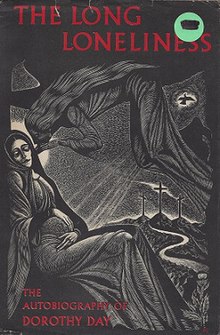
Cover art by Fritz Eichenberg
The Long Loneliness is the autobiography of Dorothy Day, published in 1952 by Harper & Brothers. In the book, Day chronicles her involvement in socialist groups along with her eventual conversion to Catholicism in 1927, and the beginning of her newspaper the Catholic Worker in 1933.[1][2]
It has been characterized as "a remarkably candid account, without piety, of her journey to faith".[1] A 1952 review in The New York Times focused on her interactions with communism and her journey away from it while staying true to her radical roots: "This book will not shock anybody. It may touch many, whatever their secular or religious faith, who lament the kindliness and sympathy that Communists found among certain left-wing groups -- and betrayed."[2]
References
[edit]- ^ a b McCarraher, Gene (June 27, 2004). "'The Long Loneliness' at 50". Commonweal Magazine (May 3, 2002). Retrieved February 6, 2022.
- ^ a b Duffus, R.L. (January 20, 1952). "Behind the Slogans She Saw the Dream in Men's Hearts; THE LONG LONELINESS. The autobiography of Dorothy Day". The New York Times. Retrieved February 6, 2022.
Further reading
[edit]- Cantwell, Daniel M. (1952). "Review of The Long Loneliness". The American Catholic Sociological Review. 13 (2): 114–115. doi:10.2307/3707377. ISSN 0362-515X. JSTOR 3707377.
- Cort, John C. (February 23, 1973). "Dorothy Day at 75". Commonweal. pp. 475–476.
- Fremantle, Anne (March 1, 1952). "'Good Like Bread'". The Saturday Review. p. 12.
- McMahon, Francis E. (August 4, 1952). "A Catholic Worker (Rev. of The Long Loneliness)". The New Republic. p. 20.
- Purinton, Carl E. (1952). "Review of The Long Loneliness. The Autobiography of Dorothy Day". Journal of Bible and Religion. 20 (3): 217. ISSN 0885-2758. JSTOR 1458455.
- Reinhold, H. A. (February 29, 1952). "The Long Loneliness of Dorothy Day". Commonweal. pp. 521–522.
- Vree, Dale (May 6, 1983). "Rev. of The Long Loneliness". Commonweal. pp. 266–269.
- White, George Abbott (1973). "Thank More, Need Less: The Catholic Worker". CrossCurrents. 23 (2): 199–205. ISSN 0011-1953. JSTOR 24457843.
Well, that’s interesting to know that Psilotum nudum are known as whisk ferns. Psilotum nudum is the commoner species of the two. While the P. flaccidum is a rare species and is found in the tropical islands. Both the species are usually epiphytic in habit and grow upon tree ferns. These species may also be terrestrial and grow in humus or in the crevices of the rocks.
View the detailed Guide of Psilotum nudum: Detailed Study Of Psilotum Nudum (Whisk Fern), Classification, Anatomy, Reproduction